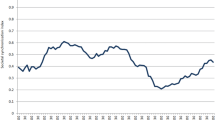Abstract
I investigate the impacts of voluntary time-of-day (TOD) rates on residential demand for electricity. My analysis is based on a sample of a survey, which provides cross-sectional data on electricity consumption and economic/demographic features for both TOD and non-TOD households in Japan. This information is used to develop an almost ideal demand system for the TOD electricity consumption during the summer. The results show that (1) household response to the high price of the peak period is relatively modest, and (2) the relative magnitudes of the price and selection effects depend on the ownership of water heaters.
Similar content being viewed by others
References
Aigner, D. ed. 1984. “The Welfare Econometrics of Peak-Load Pricing for Electricity.” Special issue of Journal of Econometrics 26: 1–252.
Aigner, D., J. Newman, and A. Tishler. 1994. “The Response to Small and Medium-Size Business Customers to Time-of-Use (TOU) Electricity Rates in Israel.” Journal of Applied Econometrics 9: 283–304.
Alston, J., K. Foster, and R. Green. 1994. “Estimating Elasticities with the Linear Approximate Almost Ideal Demand System: Some Monte Carlo Results.” Review of Economics and Statistics 76: 351–356.
Baladi, M., J. Herriges, and T. Sweeney. 1998. “Residential Response to Voluntary Time-of-Use Electricity Rates.” Resource and Energy Economics 20: 225–244
Ben-Akiva, M., and S. Lerman. 1985. Discrete Choice Analysis. Massachusetts: MIT Press.
Christensen, L., D. Jorgenson, and L. Lau. 1975. “Transcendental Logarithmic Utility Functions.” American Economic Review 65: 367–383.
Caves, D., and L. Christensen. 1980. “Econometric Analysis of Residential Time-of-Use Electricity Pricing Experiments.” Journal of Econometrics 14: 287–306.
Caves, D., J. Herriges, and K. Kuester. 1989. “Load Shifting under Voluntary Residential Time-of-Use Rates.” Energy Journal 10: 83–99.
Deaton, A., and J. Muellbauer. 1980. “An Almost Ideal Demand System.” American Economic Review 70: 312–326.
Dubin, J. 1985. Consumer Durable Choice and the Demand for Electricity. Amsterdam: North-Holland.
Dubin, J., and D. McFadden. 1984. “An Econometric Analysis of Residential Electric Appliance Holdings and Consumption.” Econometrica 52: 345–362.
Filippini, M. 1995. “Swiss Residential Demand for Electricity by Time-of-Use.” Resource and Energy Economics 17: 281–290.
Green, R., and J. Alston. 1990. “Elasticities in AIDS Model.” American Journal of Agricultural Economics 72: 442–445.
Hanneman, M. 1984. “Discrete/Continuous Models of Consumer Demand.” Econometrica 52: 541–561.
Hartman, R., and M. Doane. 1986. “Household Discount Rates Revisited.” Energy Journal 7: 139–148.
Hausman, J. 1978. “Specification Tests in Econometrics.” Econometrica 46: 1251–1271.
Hausman, J. 1979. “Individual Discount Rates and the Purchase and Utilization of Energy-Using Durables.” Bell Journal of Economics 10: 33–54.
Hausman, J., and J. Trimble. 1984. “Appliance Purchase and Usage Adaptation to a Permanent Time-of-Day Electricity Rate Schedule.” Journal of Econometrics 26: 115–139.
Japan Institute of Energy Economics. 1995. Energy and Economic Statistics. Tokyo: Japan Energy Conservation Center (in Japanese).
Lawrence, A., and D. Aigner eds. 1979. “Modelling and Forecasting Time-of-Day and Seasonal Electricity Demands.” Journal of Econometrics 9: 1–237.
Manski, C., and S. Lerman. 1977. “The Estimation of Choice Probabilities from Choice-Based Samples.” Econometrica 45: 1977–1988.
Matsukawa, I. 1996. A Cost-Benefit Analysis of Residential Time-of-Day Rates. Paper presented at the Annual Conference on Energy Systems and Economy, February 1–2: Tokyo (in Japanese).
Matsukawa, I., and N. Ito. 1998. “Household Ownership of Electric Room Air Conditioners.” Energy Economics 20: 375–387.
McFadden, D. 1981. “Econometric Models of Probabilistic Choice.” In Structural Analysis of Discrete Data with Econometric Applications, edited by C. Manski, and D. McFadden, Cambridge: MIT Press, 198–272.
Mountain, D., and E. Lawson. 1992. “A Disaggregated Nonhomothetic Modeling of Responsiveness to Residential Time-of-Use Electricity Rates.” International Economic Review 33: 181–207
Train, K. 1985. “Discount Rates in Consumers' Energy-Related Decisions: A Review of the Literature.” Energy 10: 1243–1253.
Train, K. 1990. Qualitative Choice Analysis. Cambridge: MIT Press.
Train, K., D. McFadden, and A. Goett. 1987. “Customer Attitudes and Voluntary Rate Schedules for Public Utilities.” Review of Economics and Statistics 69: 62–73.
Train, K., and G. Mehrez. 1994. “Optional Time-of-Use Prices for Electricity: Econometric Analysis of Surplus and Pareto Impacts.” RAND Journal of Economics 25: 263–283.
White, H. 1980. “A Heteroskedasticity-Consistent Covariance Matrix and a Direct Test for Heteroskedasticity.” Econometrica 48: 721–746.
Winters, A. 1984. “Separability and the Specification of Foreign Trade Functions.” Journal of International Economics 17: 239–263.
Author information
Authors and Affiliations
Rights and permissions
About this article
Cite this article
Matsukawa, I. Household Response to Optional Peak-Load Pricing of Electricity. Journal of Regulatory Economics 20, 249–267 (2001). https://doi.org/10.1023/A:1011115025920
Issue Date:
DOI: https://doi.org/10.1023/A:1011115025920




